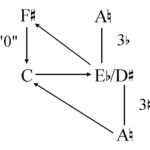The Origin of the Missing Pitch
In 1999, Henry Burnett and John Ondich analyzed numerous compositions written between the mid-sixteenth and early seventeenth centuries, beginning with pieces written in the 1540s and culminating in the innovations of the seconda pratica. They examined madrigal collections of Claudio Monteverdi both in terms of pitch and hexachordal content and realized that the vast majority of pieces unfolded eleven pitch classes (but sometimes fewer). They also discovered that sectional divisions of longer pieces—such as the rappresentativi II Combattimento di Tancredi e Clorinda and Lamento d’Arianna—unfolded eleven pitch classes and, at points of modulation, unfolded different eleven-note collections. By cataloging pitch content, the authors concluded that a three-hexachordal system—comprising both recta pitch classes (diatonic pitch classes of the durum, naturale and molle hexachords) and ficta pitch classes (non-diatonic notes required for cadence formation)—accounted for a consistent eleven-note gamut. By introducing the twelfth note, a note always a minor third or augmented second above the tonic of the system, and by concurrently deleting one of the eleven pitches of the original gamut, modulations from one three-hexachord system (or eleven pitch-class area) to another could be easily achieved.
Therefore, in a late sixteenth- or early seventeenth-century madrigal composed in a naturalis system, one without flats or sharps in the key signature, eleven pitches would occur but there would be no E-flat or D-sharp in the piece. That is, using modern, conventional jargon, pc 3 would be “missing.” Had there been a piece with a single flat in the key signature, then pc 3, the missing pitch, would be A-flat or G-sharp.
With reference to triadic tonality, Burnett speculated that a pre-compositional eleven-note sensitivity, related to aggregate completion, may very well have continued years after these early Baroque experiments. After examining a significant body of music, Burnett concluded that composers may have maintained a sensitivity to and perhaps even a conscious awareness of this issue throughout the entire period of common-practice tonality. By that point, however, around 1700, the three-hexachordal system and its modal framework had been displaced by key-centered triadic tonality in which the same conditions that previously held for hexachordal systems were now applicable to a particular key. So, C naturalis became C major, or a “C system,” or a “0 system” (since no sharps or flats were in the key signature), and the eleven pitches previously associated with the naturalis system were now incorporated into modern tonal organization.
The Matrix
During the evolution of this new theory, it became necessary to devise a graphic representation of an eleven-note gamut and its most local transformations. Therefore, this is a “matrix” for a 0 system, an eleven-note gamut with no sharps and flats, corresponding to C major or A minor of triadic tonality.

The starting point is C, defined by its “system-consonant tritone” C-F-sharp. As the arrow is followed to the right, there are two enharmonic variants of the missing pitch, E-flat or D-sharp. If E-flat is introduced, the system changes to 3 flats and the root of the new eleven-note system is E-flat. The E-flat is the root of a new eleven-note system defined by its system-consonant tritone E-flat-A-natural. The 0 system can then be regained by employing F-sharp, one variant of the missing pitch of a 3-flat system. Following the arrow, F-sharp shifts the system back to 0 and F-sharp again becomes the system-consonant tritone of the 0 system. (The use of the other missing-pitch variant in a 3-flat system, G-flat, will be discussed below.)
Had D-sharp been chosen as the variant of the missing pitch, notice that D-sharp becomes the system-consonant tritone of a 3-sharp system whose system root is A. From A, the arrow moving “northwest” back to C indicates that a C-natural nullifies the modulatory system influence of D-sharp.
The awareness of this overriding eleven-pitch-class sensitivity will become more evident if we were to examine a paradigmatic example such as the Prelude and Fugue in C major from the first volume of the Well-Tempered Clavier by J. S. Bach.
Please click here for a discussion of this work.
QUESTIONS? Confusion regarding the Missing Pitch and how it operates? Please send us your questions and comments. We would love to discuss them further with you.
